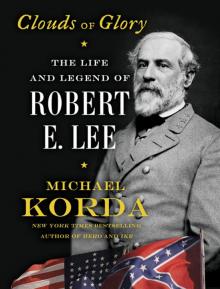- Home
- Michael Korda
Clouds of Glory Page 45
Clouds of Glory Read online
Page 45
Captain Dabney would later claim to have been confused by the new paths the Federals had cut through the woods, producing crossroads that were unfamiliar to him; but leaving to one side the wisdom of choosing him as the pathfinder (once again, the absence of Hotchkiss was a detriment), it seems odd that Stuart, with 2,000 troopers at his disposal, did not send a few ahead to reconnoiter the roads and make contact with General Branch. Stuart and Jackson never complained, then or later, about any ambiguities in Lee’s orders or in his letter giving additional directions. If Jackson’s columns were having “a fit of the slows,” as Lincoln once complained about McClellan, it can only have been a result of poor discipline and organization on the march. Jackson would have been better off riding up and down the columns exerting his formidable will on his men, or at least on poor Major Dabney, rather than riding ahead of it with Jeb Stuart.
By noon it was clear to Jackson that something was wrong. He was advancing slowly south toward Totopotomoy Creek, the only serious natural obstacle between his troops and their objective, while Ewell, invisible to him, marched his column on a parallel though longer route about two miles distant, but Branch’s brigade was still nowhere to be seen. A vigorous reconnaissance could easily have ended the confusion, and perhaps even have reached Lee himself, who was only a few miles away, on high ground overlooking Mechanicsville, but the three elements of Jackson’s force continued on their separate ways as if unaware that Longstreet, D. H. Hill, and A. P. Hill were anxiously waiting to hear the sound of Jackson’s guns in order to launch their attack.
It is only seven miles from the Virginia Central railway, which Jackson had crossed at 9 a.m., to Totopotomoy Creek, but Jackson took until 3 p.m. to reach it, which means that his infantry did not cover more than about a mile an hour—a sure sign of straggling and unauthorized halts. Stuart had sent some of his troops ahead to secure the bridge across the creek, and they skirmished briefly with an outpost of Federal cavalry holding the bridge, driving them away, although not before the Federals had set fire to it. Jackson’s engineers immediately set to work repairing it, but not until 4:30 p.m. was his column able to begin crossing it—an hour and a half after Lee’s timetable called for Jackson to have begun his attack. Jackson deployed a battery of artillery to shell the woods on the opposite bank to flush out any Union troops before the bulk of his own troops finally crossed the bridge and advanced to Hundley’s Corner, on the road to Old Raleigh, about a mile to the southeast. It was not until after 5 p.m. that Ewell, who had finally made contact with General Branch, reached Hundley’s Corner and took up his position on Jackson’s right. As Jackson understood his orders, he was to advance with A. P. Hill on his right and D. H. Hill “in support,” but neither formation was in sight. After a certain amount of soul-searching, Jackson decided to wait for further orders and “bivouacked for the night,” although he could clearly hear the sound of heavy fighting to his right.
Lee had received Jackson’s message from the night before that his column was delayed, but during the course of the day he had no reason to suppose that Jackson would not make up the lost time and be in place by 3 p.m. Lee waited with no apparent sign of impatience or anxiety through much of the long, hot day, at last taking up a position in the mid-afternoon on a ridge overlooking the Chickahominy River, less than a mile south of Mechanicsville. From here, he could see a broad, lushly green “panorama” of the intended battlefield: in front of him was the Chickahominy River, to his left the parallel Meadow Bridges, across which A. P. Hill would advance the moment General Branch made contact with Jackson. Directly ahead of Lee was the apparently deserted village of Mechanicsville; to his right, hidden by scattered brush and woods, meandered Beaver Dam Creek, on the far side of which General Porter had dug in his artillery batteries and his infantry; and still farther to Lee’s right, on the horizon, General McClellan’s observation balloons—still something of an innovation at the time—gleamed in the hot, clear sky. Like the increasingly impatient A. P. Hill, Lee saw smoke on the horizon ahead of him and shortly afterward heard the sound of guns. He very likely supposed, as A. P. Hill did, that Jackson was in place and already turning Porter’s line, since he had no way to know that the smoke was from the burning bridge, or that the gunfire was from Jackson’s attempt to clear the woods in front of him. Certainly Lee had no reason to think that General Branch was not yet even in contact with Jackson, or that Jackson’s 18,500 men were strung out behind the burning bridge for miles. In any event, A. P. Hill, already impatient since nothing had been heard from Jackson all day, leaped to the conclusion that he had begun his attack, and thus given the signal for Lee’s plan to be put in motion.
If Lee felt any anxiety at all—the face of the famous “Marble Man” was, after all, intended to hide any such emotion—it can only have been increased by the presence on the hilltop around him of President Jefferson Davis, as well as “the Secretary of State, and a number of public men,” who had ridden out from Richmond to watch the battle.
Shortly after three o’clock there were loud volleys of musket fire from the woods on the far side of the river. A. P. Hill had crossed the Meadows Bridges over the Chickahominy about two miles away and, turning right, parallel to the river, his troops were advancing toward Mechanicsville, driving Federal troops before them, while his artillery deployed behind them in the woods and opened fire. Lee, and his spectators from Richmond, could see the fighting as if on a stage before them.
When Hill’s troops approached the tiny hamlet of Mechanicsville, however, they began to come under heavy fire from the Federal batteries on Beaver Dam Creek, less than a few hundred yards away. There was still no sign of General Branch’s brigade approaching Mechanicsville, or of the Federal troops starting to withdraw from their lines on Beaver Dam Creek as Jackson turned their right with 18,500 men. On the contrary, the fire from the Union lines was hot, heavy, and steady, with no sign of panic or retreat on the part of the Federals. A. P. Hill was, in fact, attempting the impossible: a frontal assault of 11,000 men across almost a mile of open ground against 14,000 men and thirty-two guns in well-prepared positions.
Even before then Lee must have had his first strong intuition that something had gone badly wrong. Around 4 p.m., he sent a young lieutenant, Thomas W. Sydnor, who knew the local country well, to warn A. P. Hill, whose men were already in Mechanicsville, to “suspend all movement until further orders.” As the Federals retreated from Mechanicsville, a few planks were hastily thrown across the broken bridge over the Chickahominy in front of Lee, and the first of D. H. Hill’s brigades crossed. It was one thing for infantry to cross the river on planks, but another for artillery, and no pioneers had been provided for the purpose—certainly a mistake in planning—so Lee rode down to take charge of things while the president and his entourage crossed over the river in front of him. It was after 5 p.m. when Lee got to Mechanicsville and discovered that A. P. Hill had “disregarded his orders, and . . . moved on his own responsibility,” in effect starting the battle before he had any idea where or how far away Jackson might be. By this time the battle was effectively out of Lee’s control. Much of A. P. Hill’s division was pinned down along Beaver Dam Creek, and taking heavy casualties; the divisions of D. H. Hill and Longstreet were crossing the river and forming up behind his. Even General Branch’s brigade appeared at last, still with no sign of Jackson.
Lee’s attention was momentarily distracted by the presence of President Davis and his entourage, now exposed to heavy artillery fire and surrounded by wounded, dead, or dying men and horses. Politely, but firmly, he shooed Davis back, saying, “Mr. President, who is all this army and what is it doing here?” He gestured to the members of the cabinet and the politicians. Davis, apparently embarrassed, disclaimed any knowledge of why so many civilians had accompanied him. “It is not my army, General,” he said. Lee sternly told him that this was “no place for it,” and Davis, no doubt impressed by Lee’s “frigid” tone, added, “Well, General, if I withdraw, perhaps they will follow
me,” and rode down the hill until he was out of Lee’s sight, though he remained on the battlefield. One can understand that Lee wanted a moment to study his predicament without being surrounded by a gallery of civilian spectators. The sun was beginning to go down; he already knew from A. P. Hill’s experience that a direct frontal attack on Porter’s line would almost certainly be a bloody failure; and he was concerned that McClellan, when he realized that the Confederate attack north of the Chickahominy had failed, might use the opportunity to attack Richmond—just the result that Davis had feared.
Lee acted with the decisiveness that would always mark his command. He dictated an order to General Huger telling him that the trenches around Richmond must be held, in Freeman’s words, “at the point of the bayonet, if need be,” an old-fashioned euphemism for “to the last man”; and, realizing that Porter could be driven back only by turning his right flank, ordered two brigades—Brigadier General William Dorsey Pender’s and Brigadier General Roswell S. Ripley’s—to try to do so while there was still enough light. A successful turning movement followed by a frontal attack might yet save the day, but it was not to be. Pender’s and Ripley’s brigades took heavy casualties and were unable to make their way around Porter’s left; and the first day of battle ended in a bloody but futile artillery duel that went on into the night.
Very fortunately for Lee, General McClellan, who had arrived to join Porter in the late afternoon, neither ordered an attack on Richmond nor reinforced Porter. Instead, McClellan set in motion exactly what Lee had been trying to accomplish—he ordered Porter to abandon the lines he had defended so successfully along Beaver Dam Creek and withdraw to “a more defensible position” at Gaines’s Mill. McClellan also gave orders to begin the transfer the contents of his supply bases by ship from White House and West Point to the James River, thus abandoning his supply lines north of the Chickahominy, which it had been Lee’s intention to cut.
It is rare in history for a victorious general, with forces and artillery that greatly outnumber his foe’s, to give up his own bases, abandon a strong position he has successfully defended, and order a retreat of his whole army over difficult terrain to a new base, at the same time exposing his army to repeated flank attacks while it is on the move, but that is exactly what McClellan did. Lee had nothing for which to congratulate himself. Jackson’s failure to appear, whatever the reasons for it, undercut his entire plan for the battle, and the Confederates had 1,484 casualties to only 361 of the enemy’s. Still more seriously, of Lee’s 56,000 men he had been able to get only 14,000 into action. The rest were either lost, late, or delayed by crowded roads and damaged bridges. Nor of course had he any way of knowing that McClellan had already reached the extraordinary conclusion that Lee “was falling into a trap.” McClellan reassured his wife, Ellen, that he planned to “allow the enemy to cut off our communications in order to ensure success,” a very strange comment for a general in full retreat. McClellan even sent a self-congratulatory telegram to Secretary of War Stanton informing him of a “complete” victory, and adding that he had almost begun “to think we are invincible,” without mentioning that once he had given up his supply lines and bases north of the Chickahominy, he had as good as given up any hope of laying siege to Richmond, never mind taking it. Lee had already accomplished his first priority: McClellan, who on June 25 had been within seven miles of Richmond, was now moving his army farther away from it.
Gaines’s Mill—June 27, 1862
Perhaps the most important decision Lee made during the night of June 26 was to attack again early in the morning. He did not brood on what had gone wrong at Mechanicsville, or consider retreating to defend Richmond. Lee, like Wellington, indeed like all great generals, had the ability to look on the misery of a battlefield, absorb its horrors—he never turned away from them—and then move on calmly to his next decision.* During the whole “Seven Days” Lee continued to attack, despite whatever had gone wrong the day before. He, his staff, and his generals were, in effect, learning how to fight as a single army, and perhaps the most important thing they now understood was that Lee did not waste time consolidating or reorganizing his army, or waiting to see what the enemy would do. He simply attacked, determined to keep the enemy off balance and to drive him farther and farther away from Richmond. McClellan thought that the farther Lee advanced, the more likely he was to make a mistake, and of course he was right—Lee committed mistake after mistake in the week ahead, but he never gave McClellan a chance to exploit his errors. Day by day he pushed McClellan’s army back toward the James River.
Lee’s plan was to turn both ends of Porter’s line at Beaver Dam Creek. At the same time, he sent Walter Taylor off to find Jackson—something he should have done the day before. It was brutally hot, promising dry roads, and therefore an opportunity for a rapid advance. But by the time Lee was ready to begin the assault to the north and south of Beaver Dam Creek, Porter had abandoned the positions he had fought so hard for the previous day, and was in full, but orderly retreat toward New Cold Harbor, about five miles to the east. There, the high ground behind Powhite Creek would enable Porter to make a vigorous stand, with his left resting firmly on the bulk of McClellan’s forces facing Richmond to the south of the Chickahominy, and connected to them by two bridges over the river, so that he could receive substantial reinforcements if needed. It was a naturally strong position. When Porter had been at Beaver Dam Creek he was, in effect, isolated in a salient, ahead of the bulk of McClellan’s army. Now that Union army was concentrated in an arc almost ten miles long with good interior lines, a formidable force of nearly 100,000 men in total, 57,000 of them north of the river.
Lee had only 35,000, still spread out on the move in a haphazard way, but he was relying on General Magruder, south of the Chickahominy, to distract McClellan and keep his attention focused in the wrong direction. From early morning, Magruder marched his division back and forth through the woods, creating the impression of a much larger force preparing to attack. He reinforced this pantomime by raising what was at the time the Confederacy’s only hot air balloon over Richmond,* to give the impression that McClellan’s army was about to be attacked both south and north of the Chickahominy.
Porter was too busy digging in behind Powhite Creek on his left and Boatswain’s Swamp on his front to pay much attention to what was going on facing McClellan’s other four corps, which were five miles away and on the south side of the river; but Magruder’s charade made a substantial impression on McClellan, who convinced himself that Lee had 100,000 men in and around Richmond, and that he himself was “outnumbered . . . every where.” He had already sent his engineers out “to bridge White Oak Swamp” behind him—the most direct path for his army to retreat south to the James River.
By 9 a.m. Lee had four columns moving eastward along separate roads in the direction of New Cold Harbor and Gaines’s Mill to engage Porter. The problem of inadequate maps continued to plague Lee, who was still working from a large hand-drawn map that was almost devoid of topographical details and failed to show Boatswain’s Swamp, a significant natural obstacle directly in the path of Jackson and D. H. Hill.
Lee himself followed the path of Longstreet’s division to the house of William Gaines, whose mill would give the forthcoming battle its name, and from whose peach orchard a Federal battery was firing. There, he learned that Jackson and A. P. Hill had at last made contact, and that the head of Jackson’s column had reached Walnut Grove Church, about three miles northwest of the Gaines house. Lee rode there at once and found Jackson and A. P. Hill talking to each other. Hill withdrew tactfully, Lee and Jackson dismounted, and Lee seated himself on a tree stump while Jackson stood, with, in the words of his latest biographer, “the seedy appearance of a farmer who had been plowing all day.” It is unfortunate that neither of them gave an account of their conversation—it is hard to imagine that even a man as tactful as Lee would not have at least mentioned Jackson’s failure to get his 18,500 men to the battlefield the previous day—but
Lee’s confidence in Jackson had not been shaken. The two men talked for the best part of an hour as Lee explained his plan for the next day, confirmed that D. H. Hill would continue to support Jackson, and urged Jackson to make haste toward Cold Harbor.
Lee’s concept of the battle was once again flawed by the inadequacies of his map. He supposed that Porter, having withdrawn his forces from Beaver Dam Creek, would take up a similar position, running from north to south, along Powhite Creek, where the rising ground provided a natural defensive position. Lee’s parting instruction to Jackson was to turn the Federal line along Powhite Creek—in short, to repeat what ought to have been his role the previous day.
By the time Jackson was on his way back to alert D. H. Hill, Lee had already become aware that Powhite Creek was virtually undefended, and that McClellan instead had ordered Porter to take up a position facing north, rather than west, about a mile farther on from Powhite Creek, on a hill the approach to which was made difficult by the marshy course of the sluggish Boatswain’s Creek, which did not appear on any of the Confederate maps. The acerbic Confederate general Richard Taylor complained, “We had much praying at various headquarters, and large reliance on special providence; but none were vouchsafed, by a pillar of cloud or a fire to supplement our ignorance.” This was a none too subtle dig at his commander Stonewall Jackson. Taylor later described Porter’s new line with the accuracy of a man who has fought over it: “McClellan had chosen an excellent position, covering his military bridges over the Chickahominy. His left, resting on the river, and his center, were covered by a small stream, one of its affluents, boggy and of difficult passage. His right was on high ground, near Cold Harbor, in a dense thicket of pine-scrub, with artillery massed. This position, three miles in extent, and enfiladed in front by heavy guns on the south side of the Chickahominy, was held by three lines of infantry, one above the other on the rising ground, which was crowned with numerous batteries, concealed by timber.” This naturally strong position was held by nearly 40,000 men, and Porter had been given enough time to dig shallow trenches and rifle pits, and to erect abatis, felled trees and branches with the sharpened ends pointed toward the enemy, making it even more formidable.

 Passing
Passing Another Life
Another Life Clouds of Glory
Clouds of Glory Hero: The Life and Legend of Lawrence of Arabia
Hero: The Life and Legend of Lawrence of Arabia Cat People
Cat People Hero
Hero With Wings Like Eagles: A History of the Battle of Britain
With Wings Like Eagles: A History of the Battle of Britain Ulysses S. Grant
Ulysses S. Grant